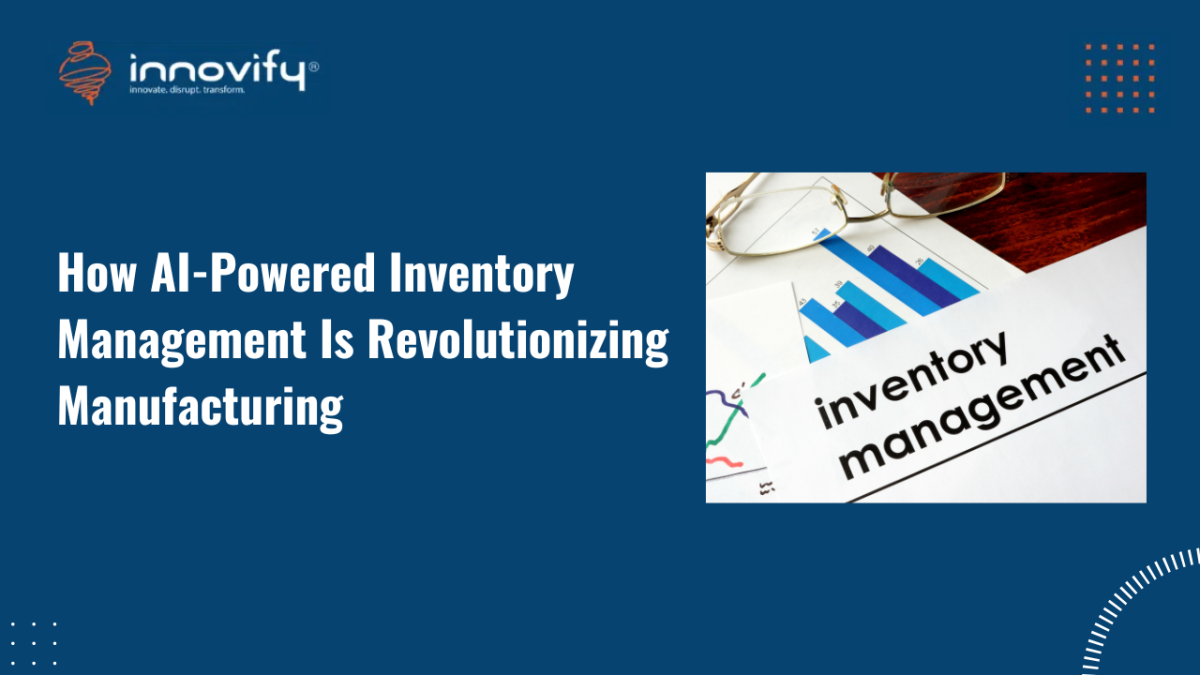AI/ML
How AI-Powered Inventory Management Is Revolutionizing Manufacturing
Imagine running a factory where you always have just the right amount of materials on hand – no more, no less. You’re not scrambling to order parts at the last minute, nor are you stuck with a warehouse full of stuff you don’t need. That’s the magic of AI-powered inventory management in manufacturing. It’s like having a super-smart assistant who knows exactly what you’ll need, when you’ll need it, and how to keep everything running smoothly. Let’s break down how this technology is transforming manufacturing, saving money, and keeping production lines humming – plus, we’ll look at some real-world examples to see it in action.
What is AI-Powered Inventory Management?
At its core, AI-powered inventory management uses artificial intelligence to keep track of materials, predict what you’ll need, and make sure you’re never caught off guard. It’s all about analyzing data – think production schedules, past sales, market trends, and even real-time stock levels – to make smart decisions automatically. Instead of guessing how much inventory to keep, AI does the heavy lifting, helping manufacturers strike the perfect balance between having enough stock and not wasting money on excess.
How It Works
Here’s a peek at how AI makes inventory management a breeze:
Data Gathering: AI pulls in data from all over – sensors in your warehouse, sales records, production plans, even weather forecasts or seasonal trends.
Demand Forecasting: It crunches the numbers to predict what you’ll need in the future, like how many widgets you’ll produce next month or how much raw material you’ll use.
Real-Time Monitoring: AI keeps an eye on your inventory 24/7, tracking stock levels as they change during production.
Automated Replenishment: When stock gets low, AI can automatically reorder materials, ensuring you’re never out of what you need.
Continuous Improvement: The more data it gets, the better AI becomes at predicting and optimizing your inventory.
Why It’s a Big Deal
No More Overstocking: Too much inventory ties up cash and takes up space. AI helps you keep just what you need, freeing up funds for other things.
Avoid Stockouts: Running out of materials can halt production and frustrate customers. AI ensures you’ve got enough to keep going.
Lower Costs: Less waste and better planning mean you’re not throwing money away on expired goods or rush orders.
Smoother Operations: With the right materials always on hand, production lines keep moving without delays.
Better Decision-Making: AI gives you insights to plan ahead, whether it’s for a busy season or a new product launch.
Digging Deeper: How AI Optimizes Inventory in Manufacturing
Let’s get into the nitty-gritty of how AI takes inventory management to the next level in manufacturing.
Forecasting Demand with Precision
AI doesn’t just look at what you’ve used in the past – it looks at everything. It can factor in upcoming production schedules, seasonal spikes (like holiday demand), market trends, and even external factors like supply chain disruptions. For example, if you’re a toy manufacturer, AI might notice that demand for a certain toy spikes every December. It’ll make sure you’ve got extra plastic and packaging materials ready well in advance, so you’re not caught off guard.
Real-Time Inventory Tracking
Gone are the days of manually counting stock or waiting for a monthly report. AI uses sensors, barcodes, and IoT (Internet of Things) devices to track inventory in real time. If a machine uses up a batch of screws, the system updates instantly, so you always know exactly what’s on hand. This means you can catch low stock levels before they become a problem and avoid those “oh no, we’re out of stock” moments.
Automating Replenishment
AI doesn’t just tell you what’s running low – it can take actions. By integrating with your supply chain systems, it can place orders automatically when stock hits a certain threshold. For instance, if you’re running low on steel for your production line, AI can notify your supplier and reorder, all without you lifting a finger. It can even prioritize orders based on urgency, ensuring critical materials arrive first.
Reducing Waste and Spoilage
For industries dealing with perishable goods, like food manufacturing, AI is a lifesaver. It can predict how much you’ll use before items expire and adjust orders accordingly. This means less waste, fewer spoiled goods, and a smaller environmental footprint. Plus, it saves you from the headache of throwing out overstocked items that go bad.
Improving Cash Flow
Inventory isn’t just stock on a shelf – it’s money sitting there. Overstocking ties up cash you could use for other things, like hiring more staff or upgrading equipment. By keeping inventory lean, AI helps you free up that cash, improving your overall financial health. It’s like giving your factory a financial tune-up.
Real-World Examples of AI in Inventory Management
Let’s see how this tech is making a difference in the real world.
Food and Beverage Manufacturing
In the food and beverage industry, where ingredients can spoil quickly, AI is a game-changer. Take a bakery that produces thousands of loaves of bread daily. They use AI to track flour, yeast, and other ingredients in real time. The system looks at production schedules (e.g., more bread needed for a big holiday order), seasonal trends (e.g., higher demand in winter), and past usage to predict future needs. If the AI sees that flour stocks are running low and a big order is coming up, it automatically reorders, ensuring the bakery never misses a beat. This not only prevents production delays but also cuts down on waste – no more throwing out expired yeast or overstocked flour.
Automotive Manufacturing
Car manufacturers deal with thousands of parts, from tiny screws to massive engine components. An automotive plant might use AI to manage its inventory of brake pads. The system tracks how many pads are used daily, looks at upcoming production goals (e.g., a new car model launch), and even considers supplier lead times. If it predicts a shortage, it reorders well in advance, ensuring the assembly line keeps moving. This has helped companies like Ford and Toyota reduce inventory costs by millions while keeping production on track.
Electronics Manufacturing
In electronics, where components like microchips can be expensive and hard to source, AI helps manufacturers stay ahead. A company making smartphones might use AI to monitor its stock of screens and batteries. By analyzing sales forecasts, production timelines, and global supply chain disruptions (like a chip shortage), AI ensures the company has enough parts to meet demand without overstocking. This precision has been crucial for companies like Samsung, helping them navigate tricky supply chain challenges.
Pharmaceutical Manufacturing
In pharmaceuticals, where raw materials for drugs can be costly and have strict shelf lives, AI ensures nothing goes to waste. A drug manufacturer might use AI to manage its stock of active ingredients. The system tracks usage, predicts future needs based on production plans, and ensures materials are used before they expire. This not only saves money but also ensures compliance with regulations, as expired materials can’t be used in production.
Challenges and How AI Overcomes Them
Inventory management isn’t always smooth sailing – there are hurdles to overcome. But AI has answers for those too.
Supply Chain Disruptions: Unexpected events, like a supplier delay or a global shipping issue, can throw off your inventory plans. AI can predict these disruptions by analyzing external data (like news or shipping reports) and suggest alternatives, like sourcing from a different supplier.
Seasonal Fluctuations: Demand can spike or drop depending on the time of year. AI looks at historical trends and current market signals to adjust inventory levels, so you’re ready for busy seasons without overstocking during slow ones.
Complex Production Needs: Some manufacturers produce hundreds of products, each with different material needs. AI can handle this complexity, managing inventory for each product line separately while optimizing overall stock levels.
The Future of Inventory Management in Manufacturing
AI-powered inventory management is just getting started. As technology evolves, we’ll see even more exciting changes:
Smarter Supply Chains: AI will integrate more deeply with suppliers, creating fully automated supply chains where materials flow seamlessly from supplier to factory.
Sustainability Wins: By reducing waste and optimizing resources, AI will help manufacturers meet eco-friendly goals, like cutting carbon emissions.
Personalized Production: As manufacturers move toward custom products (think made-to-order cars or personalized medicine), AI will ensure inventory systems can handle the complexity of small-batch production.
Ready to Streamline Your Inventory?
If the idea of never running out of materials – or wasting money on excess stock – sounds appealing, AI-powered inventory management might be the answer. It’s already helping manufacturers big and small save money, reduce waste, and keep production running smoothly. Whether you’re making cars, baking bread, or producing life-saving drugs, there’s a solution that can work for you.
Curious about how AI can transform your inventory management? Let’s chat about your needs and explore how custom AI solutions can make your factory more efficient than ever. Reach out today, and let’s get started!




